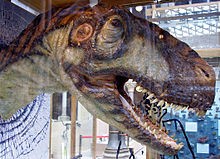Megalosaurs
| Megalosauroids Temporal range: Middle Jurassic - Late Cretaceous, 170–93 Ma Possible Late Maastrichtian record |
|
|---|---|
 |
|
| Life restoration of the megalosaurid Eustreptospondylus. | |
| Scientific classification | |
| Kingdom: | Animalia |
| Phylum: | Chordata |
| Class: | Reptilia |
| Clade: | Dinosauria |
| Order: | Saurischia |
| Suborder: | Theropoda |
| Clade: | Orionides |
| Superfamily: |
†Megalosauroidea Huxley, 1889 |
| Type species | |
|
†Megalosaurus bucklandii Mantell, 1827 |
|
| Subgroups | |
|
|
| Synonyms | |
Megalosauroidea is a group of tetanuran theropod dinosaurs that lived from the Middle Jurassic to the Late Cretaceous period. Members of the group include Spinosaurus, Megalosaurus, and Torvosaurus.
The clade Megalosauroidea is defined as Megalosaurus bucklandii and all taxa sharing a more recent common ancestor with it than with Allosaurus fragilis or Passer domesticus.
The name Spinosauroidea is sometimes used in place of Megalosauroidea. The superfamily Spinosauroidea was named in 1915 by Ernst Stromer. It is a synonym of Megalosauroidea in almost all modern phylogenetic analyses, and it is therefore redundant. Spinosauroidea was defined as a clade in 1998 by Paul Sereno as the node clade containing the common ancestor of Spinosaurus and Torvosaurus and all its descendants. Thomas Holtz in 2004 defined a branch clade with the same name containing all species closer to Spinosaurus than to Passer domesticus. The ICZN holds that even clade names (which do not yet have any governing body) should be replaced if having a traditional taxon suffix and being synonyms of ranked taxa at or below the superfamily level. The seniority of Megalosauroidea was not followed in most paleontological literature during the 1990s and early 2000s. A series of papers supporting the validity of Megalosaurus as a genus, the relationships of megalosauroids, and the placement of "spinosauroids" among them, published between 2008 and 2010 argued that Megalosauroidea was in fact the valid name for the group.
...
Wikipedia
